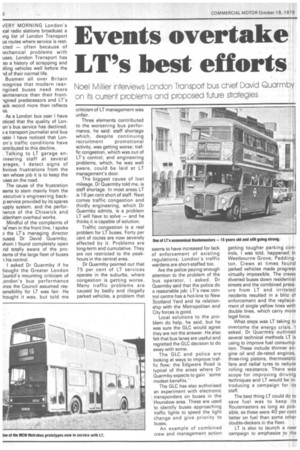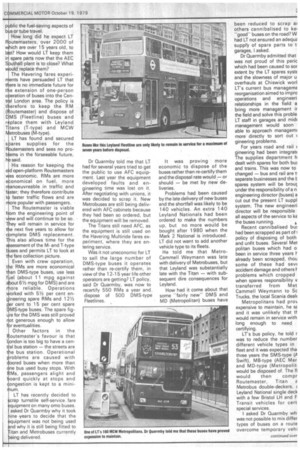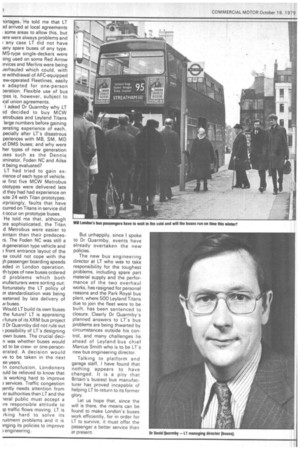Events overtake LT's best efforts
Page 30

Page 31

Page 32

If you've noticed an error in this article please click here to report it so we can fix it.
Noel Villier interviews London Transport bus chief Davic Quarmby on its current prooLems and pr000sed fu--ure strategies VERY MORNING London's ,cal radio stations broadcast a ing list of London Transport us routes where service is restcted — often because of iechanical problems with uses. London Transport has so a history of scrapping and :fling vehicles well before the id of their normal life.
Busmen all over Britain cognise that modern rearngined buses need more laintenance than their frontigined predecessors and LT's ack record more than reflects iis.
As a London bus user I have oticed that the quality of Lonon's bus service has declined; 3 a transport journalist and bus )ster I have noticed that Lonon's traffic conditions have ontributed to this decline.
Talking to LT garage enineering staff at several arages, I detect signs of bvious frustrations from the len whose job it is to keep the uses on the road.
The cause of the frustration eems to stem mainly from the xecutive's engineering backp service provided by its spares upply system, and the perforlance of the Chiswick and 1/41denham overhaul works.
Mindful of the complaints of id men in the front line, I spoke D the LT's managing director Rises) Dr David Quarmby, vhom I found completely open nd totally aware of the proilems of the large fleet of buses his control.
I asked Dr Quarmby if he hought the Greater London s,ouncil's mounting criticism of .ondon's bus performance ,ince the Council assumed res)onsibility for LT was fair. He hought it was, but told me criticism of LT management was unfair.
Three elements contributed to the worsening bus performance, he said: staff shortage which, despite continuing recruitment promotional activity, was getting worse; traffic congestion, which was out of LT's control; and engineering problems, which, he was well aware, could be laid at LT management's door.
The biggest cause of lost mileage, Dr Quarmby told me, is staff shortage. In most areas LT is 16 per cent short of staff. Next comes traffic congestion and thirdly engineering, which Dr Quarmby admits, is a problem LT will have to solve — and he thinks. it is capable of solution.
Traffic congestion is a real problem for LT buses. Forty per cent of routes are now severely affected by it. Problems are long-term and cumulative. They are not restricted to the peakhours in the central area.
Dr Quarmby pointed out that 75 per cent of LT services operate in the suburbs, where congestion is getting worse. Many traffic problems are caused by badly and illegally parked vehicles, a problem that seems to have increased for lack of enforcement of existing regulations; London's traffic wardens are short-staffed too.
Are the police paying enough attention to the problem of the bus operator, I asked. Dr Quarmby said that the police do a reasonable job: LT's new control centre has a hot-line to New Scotland Yard and its relationship with the Metropolitan and City forces is good.
Local solutions to the problem do help, he said, but he was sure the GLC would agree they are not the answer. He also felt that bus lanes are useful and regretted the GLC decision to do away with some.
The GLC and .police are looking at ways to improve traffic flow; the Edgware Road is typical of the areas where Dr Quarmby expects to gain -some modest benefits."
The GLC has also authorised an experiment with electronic transponders on buses in the ,Hounslow area. These are used to identify buses approaching traffic lights to speed the light change and give priority to buses.
An example of combined crew and management action getting tougher parking controls, I was told, happened in Westbourne Grove, Paddington. Crews at times found parked vehicles made progress virtually impossible. The crews diverted buses down residential streets and the combined pressure from LT and irritated residents resulted in a blitz of enforcement and the replacement of single yellow lines with double lines, which carry more legal force.
What steps was LT taking to overcome the energy crisis, I asked. Dr Quarmby outlined several technical methods LT is using to improve fuel consumption. These include thinner engine oil and de-rated engines, three-ring pistons, thermostatic fans and radial tyres to reduce rolling resistance. There was scope for improving driving techniques and LT would be introducing a campaign for its staff.
The best thing LT could do to save fuel was to keep its Routemasters as long as possible, as these were 40 per cent better on fuel than some other double-deckers in the fleet.
LT is also to launch a new campaign to emphasize to the p blic the fuel-saving aspects of b s or tube travel.
How long did he expect LT Routemasters, over 2000 of which are over 15 years old, to last? How would LT keep them in spare parts now that the AEC S uthall plant is to close? What uld replace them?
The Havering fares experients have persuaded LT that t ere is no immediate future for t e extension of one-person o eration of buses into the Cent I London area. The policy is t erefore to keep the RM ( outemaster) and dispose of MS (Fleetline) buses and replace them with Leyland Titans (T-type) and MCW Metrobuses (M-type). . LT has found and secured spares supplies for the Routemasters and sees no proems in the forseeable future, h said.
His reason for keeping the o d open-platform Routemasters as economic. RMs are more etonomical on fuel, more manoeuvreable in traffic and faster; they therefore contribute to faster traffic flows and are more popular with passengers. .
The Routemaster is viable ftom the engineering point of view and will continue to be so. They will remain in service for the next five years to allow for complete DMS replacement. This also allows time for the assessment of the Mand T-type buses and permits LT to look at the fare collection picture.
i Even with crew operation, the RMs are more economical than DMS-type buses, use less fuel (about 11 mpg against .about 61/2 mpg for DMS) and are More reliable. Operations worked with 51/2 per cent engineering spare RMs and 121/2 per cent to 15 per cent spare DMS-type buses. The spare figure for the DMS was still proved not generous enough to allow for eventualities.
Other factors in the Routemaster's favour is that London is too big to have a central bus station — the streets are the bus station. Operational problems are caused with doored buseswhen more than one bus used busy stops. With RMs, passengers alight and board quickly at stops and congestion is kept to a minimum.
LT has recently decided to Scrap turnstile self-service. fare quipment on many omo buses. asked Dr Quarmby why it took ine .years to decide that the equipment was not being used and why it is still being fitted to Titan and Metrobuses currently being delivered. Dr Quarmby told me that LT had for several years tried to get the public to use AFC equipment. Last year the equipment developed faults and engineering time was lost on it. After negotiating with unions, it was decided to scrap it. New Metrobuses are still being delivered with AFC cabinets because they had been so ordered, but the equipment will be removed.
The Titans still need AFC, as the equipment is still used on the Havering Multiride fares experiment, where they are entering service.
Was it not uneconomic for LT to sell the large number of DMS-type buses it operates rather than re-certify them, in view of the 1 2-1 5 year life other operators are getting? LT policy, said Dr Quarmby, was now to recertify 550 RMs a year and dispose of 500 DMS-type Fleetlines. It was proving more economic to dispose of the buses rather than re-certify them and the disposal rate would or should — be met by new deliveries.
Problems had been caused by the late delivery of new buses and the shortfall was likely to be 140 vehicles. An extra 140 Leyland Nationals had been ordered to make the numbers up, but no more would be bought after 1980 when the Mark 2 National is introduced. LT did not want to add another vehicle type to its fleets.
He told me that MetroCammell Weymann was late with delivery of Metrobuses, but that Leyland was substantially late with the Titan — with subsequent dire consequences for Leyland.
How had it come about that some "fairly newDMS and MD (Metropolitan) buses have been reduced to scrap ai others cannibalised to ke, "good" buses on the road? W had LT not ensured an adequE supplV of spare parts to t garages, I asked.
Dr Quarmby admitted that was not proud of this peric which had been caused to sor extent by the LT spares systE and the slowness of major u overhauls at Chiswick worl LT's current bus managemE reorganisation aimed to impro operations and engineeri relationships in the field a bring more management ir the field and solve this proble LT staff in garages and mid( management would soon able to approach managern( more directly to sort out ( gineering problems.
For years road and rail ( gineering had been integrat( The supplies department h dealt with spares for both but and trains. This was now to changed — bus and rail are t, separate businesses and the t spares system will be brouc. under the responsibility of a n engineering director (buses) a cut out the present LT suppl system. The new engineeri director will be responsible all aspects of the service to kE the buses running.
Recent cannibalised buf. had been scrapped as part of i policy of disposing of both and unfit buses. Several Met politan buses which had o been in service three years 1already been scrapped, thou some of these had sev( accident damage and otherslproblems which cropped when spares responsibility v transferred from Met Cammell Weymann to Sc Trucks, the local Scania deal(
Metropolitans had pro%, expensive to maintain, he sz• and it was unlikely that If would remain in service with long enough to need certifying.
LT's bus policy, he told r was to reduce the number different vehicle types in • fleet and it was expected tha three years the SMS-type (A Swift), MB-type (AEC Mer and MD-type (Metropolit. would be disposed of. The fl would then con-1pr Routemaster, Titan a Metrobus double-deckers, Leyland National single deck with a few Bristol LH and F Transit vehicles for cert special services.
asked Dr Quarmby wft was not possible to mix differ types of buses on a route overcome temporary vehi
-*nage& He told me that LT ad arrived at local agreements 'some areas to allow this, but iere were always problems and any case LT did not have any spare buses of any type. MS-type single-deckers were aing used on some Red Arrow avices and Merlins were being derhauled which could, with le withdrawal of AFC-equipped .ew-operated Fleetlines, easily e adapted for one-person aeration. Flexible use of bus
• pes is, however, subject to cal union agreements.
I asked Dr Quarmby why LT Id decided to buy MCW etrobuses and Leyland Titans large numbers before gaining )erating experience of each, pecially after LT's disastrous .periences with MB, SM, MD id DMS buses; and why were her types of new generation ises such as the Dennis )minator, Foden NC and Ailsa a being evaluated?
LT had tried to gain ex wience of each type of vehicle.
ie first five MCW Metrobus ototypes were delivered late d they had had experience on :ute 24 with Titan prototypes.
uprisingly, faults that have curred on Titans in service did (t occur on prototype buses. He told me that, although are sophisticated, the Titan d Metrobus were easier to aintain than their predecesrs. The Foden NC was still a it-generation type vehicle and front entrance layout of the sa could not cope with the jh passenger boarding speeds eded in London operation. th types of new buses ordered d problems which both inufacturers were sorting out; fortunately the LT policy of at standardisation was being eatened by late delivery of N buses.
Would LT build its own buses the future? LT is appraising ?future of its XRM bus project J Dr Quarmby did not rule out ? possibility of LT's designing own buses. The crucial decin was whether buses would ad to be crewor one-personerated. A decision would ve.to be taken in the next ee years.
In conclusion, Londoners )uld be relieved to know that is working hard to improve 3 services. Traffic congestion iently needs attention from er authorities than LT and the -ieral public must accept a ire responsible attitude to :p traffic flows moving. LT is rking hard to solve its ruitment problems and it is inging its policies to improve ; engineering.
But unhappily, since I spoke to Dr Quarmby. events have already overtaken the new policies.
The new bus engineering director at LT who was to take responsibility for the toughest problems, including spare part material supply and the performance of the two overhaul works, has resigned for personal reasons and the Park Royal bus plant, where 500 Leyland Titans due to join the fleet were to be built, has been sentenced to closure. Clearly Dr Quarmby's planned answers to LT's bus problems are being thwarted by circumstances outside his control, and many challenges lie ahead of Leyland bus chief Marcus Smith who is to be LT's new bus engineering director.
Talking to platform and garage staff, I have found that nothing appears to have changed. It is a pity that Britain's busiest bus manufacturer has proved incapable of helping LT to return to its former glory.
Let us hope that, since the will is there, the means can be found to make London's buses work efficiently, for in order for LT to survive, it must offer the passenger a better service than at present.












































































































































